Geodiversity and Geoheritage to Promote Geotourism Using Augmented Reality and 3D Virtual Flights in the Arosa Estuary (NW Spain)
Abstract
1. Introduction
2. Materials and Methods
2.1. Study Area
2.2. Geological Context
2.3. Geomorphological Context
2.4. Methods
2.4.1. Geosite Evaluation
2.4.2. Three-Dimensional Virtual Itinerary
3. Results and Discussion
3.1. Geosites Description
3.2. Geoheritage Evaluation
3.3. Three-Dimensional Virtual Itinerary
4. Conclusions
Author Contributions
Funding
Data Availability Statement
Acknowledgments
Conflicts of Interest
References
- Díaz-Martínez, E.; Salazar, Á.; Cortés, Á.G. El patrimonio geológico en España. Enseñanza Cienc. Tierra 2014, 22, 25. [Google Scholar]
- Méndez, G.; Rey, D. Perspectiva histórica del conocimiento geológico de las rías gallegas. J. Iber. Geol. 2000, 26, 21–44. [Google Scholar]
- Nonn, H. Los sedimentos antiguos de la Arosa estuary. Algunas conclusiones geomorfológicas. Notas Comun. Inst. Geológico Min. España 1964, 74, 143–155. [Google Scholar]
- Sole Sabaris, L.; De teran, M.; Otros. Geografía Regional de España. Tomo II; Editorial Ariel S.A.: Madrid, Spain, 1983; pp. 31–58. [Google Scholar]
- Martín Serrano, A. El relieve del Macizo Hespérico: Génesis y cronología de los principales elementos morfológicos. Cuad. Lab. Xeolóxico Laxe 1994, 19, 37–56. [Google Scholar]
- Martínez-Graña, A. Formación y Dinámica de las Rías Gallegas; de Pesca, C., Ed.; Xunta de Galicia: Madrid, Spain, 1994; pp. 1–36. [Google Scholar]
- García-Cortés, Á.; Carcavilla, L.; Vegas, J.; Díaz-Martínez, E. Documento Metodológico para la Elaboración del Inventario Español de Lugares de Interés Geológico; Instituto Geológico y Minero de España, IGME: Madrid, España, 2018; Available online: http://www.igme.es/patrimonio/descargas/METODOLOGIA%20IELIG%20V16%20actualizaci%C3%B3n%202018.pdf (accessed on 15 April 2023).
- Carcavilla Urqauí, L.; López Martínez, J.; Durán Valsero, J.J. Patrimonio Geológico y Geodiversidad: Investigación, Conservación, Gestión y Relación con los Espacios Naturales Protegidos; Instituto Geológico y Minero de España (IGME), Ministerio de Educación y Ciencia, Cuadernos Museo Geominero: Madrid, Spain, 2007; Volume 7, p. 360. [Google Scholar]
- Carcavilla, L.; Durán, J.J.; y López-Martínez, J. Geodiversidad: Concepto y relación con el patrimonio geológico. Geo-Temas 2008, 10, 1299–1303. [Google Scholar]
- Pescatore, E.; Bentivenga, M.; Giano, S.I. Geoheritage and Geoconservation: Some Remarks and Considerations. Sustainability 2023, 15, 5823. [Google Scholar] [CrossRef]
- Zakharovskyi, V.; Németh, K. Quantitative qualitative method for quick assessment of geodiversity. Land 2021, 10, 946. [Google Scholar] [CrossRef]
- Brilha, J. Inventory and quantitative assessment of geosites and geodiversity sites: A review. Geoheritage 2016, 8, 119–134. [Google Scholar] [CrossRef]
- Fepuleai, A.; Weber, E.; Németh, K.; Muliaina, T.; Lese, V. Eruption styles of Samoan volcanoes represented in tattooing, language and cultural activities of the indigenous people. Geoheritage 2017, 9, 395–411. [Google Scholar] [CrossRef]
- Zakharovskyi, V.; Németh, K. Comparison of different scales of qualitative-quantitative as-sessment of geodiversity. Geographies 2022, 12, 45–55. [Google Scholar]
- Pedraza Gilsanz, J.D. Geomorfología: Principios, Métodos y Aplicaciones; Rueda: Madrid, Spain, 1996. [Google Scholar]
- Sanjaume, E.; Gracia, F.J. Las Dunas en España; España: Cadiz, Spain, 2011. [Google Scholar]
- Sánchez-Ferris, E.J.; Fierro-Bandera, I.; Aberasturi-Rodríguez, A.; Navarro-Pedreño, J.; Montoya-Belló, P. La valoración del patrimonio geológico y paleontológico como herramienta de gestión: El Modelo FOPALI. Span. J. Palaeontol. 2019, 34, 35–56. [Google Scholar] [CrossRef]
- Martínez-Graña, A.M.; Goy, J.L.; González-Delgado, J.Á.; Cruz, R.; Sanz, J.; Cimarra, C.; De Bustamante, I. 3D virtual itinerary in the geoheritage from natural areas in Salamanca-Ávila-Cáceres, Spain. Sustainability 2019, 11, 144. [Google Scholar] [CrossRef]
- Hincapie, M.; Cifuentes, L.M.; Valencia-Arias, A.; Quiroz-Fabra, J. Geoheritage and immersive technologies: Bibliometric analysis and literature review. Episodes 2022, 46, 022016. [Google Scholar] [CrossRef]
- Garofano, M. Geowatching, a term for the popularisation of geological heritage. Geoheritage 2015, 7, 25–32. [Google Scholar] [CrossRef]
- Newsome, D.; Dowling, R. Geoheritage and geotourism. In Geoheritage: Assessment, Protection, and Management; Elsevier Inc.: Amsterdam, The Netherlands, 2018; pp. 305–321. [Google Scholar] [CrossRef]
- Pica, A.; Reynard, E.; Grangier, L.; Kaiser, C.; Ghiraldi, L.; Perotti, L.; Del Monte, M. GeoGuides, Urban Geotourism Offer Powered by Mobile Application Technology. Geoheritage 2018, 10, 311–326. [Google Scholar] [CrossRef]
- Graña, A.M.M.; Goy, J.L.; Zazo, C. Cartografia geomorfologica y patrimonio geologico Cuaternario en la Arosa estuary (Pontevedra-La Coruña, Galicia, España). Contrib. Estud. Periodo Cuatern. 2007, 229–230. [Google Scholar]
- Gül, M.; Küçükuysal, C. Geotourism activities via marine excursion: Muğla, SW Türkiye. Geoheritage 2023, 15, 64. [Google Scholar] [CrossRef]
- Stanley, K.B.; Resler, L.M.; Carstensen, L.W. A Public Participation GIS for Geodiversity and Geosystem Services Mapping in a Mountain Environment: A Case from Grayson County, Virginia, U.S.A. Land 2023, 12, 835. [Google Scholar] [CrossRef]
- Silva, J.P.; Rodrigues, C.; Pereira, D.I. Mapping and Analysis of Geodiversity Indices in the Xingu River Basin, Amazonia, Brazil. Geoheritage 2015, 7, 337–350. [Google Scholar] [CrossRef]
- Bétard, F.; Peulvast, J.-P. Geodiversity Hotspots: Concept, Method and Cartographic Application for Geoconservation Purposes at a Regional Scale. Environ. Manag. 2019, 63, 822–834. [Google Scholar] [CrossRef]
- Vital, H.; Domínguez, J.M.L.; Bastos, A.C.; de Araújo, T.C.M. Geodiversidad y Biodiversidad de la Plataforma Tropical del Nordeste de Brasil. In Tropical Marine Environments of Brazil. La Serie de Libros de Estudios Latinoamericanos; Dominguez, J.M.L., de Kikuchi, R.K.P., Filho, M.C.d.A., Schwamborn, R., Vital, H., Eds.; Springer: Cham, Switzerland, 2023. [Google Scholar] [CrossRef]
- Martinez-Graña, A.M.; Goy, J.L.; Cardeña, C.Z. Natural heritage mapping of the las batuecas-sierra de Francia and Quilamas Nature Parks (SW Salamanca, Spain). J. Maps 2011, 7, 600–613. [Google Scholar] [CrossRef]
- González-Delgado, J.A.; Martínez-Graña, A.; Holgado, M.; Gonzalo, J.C.; Legoinha, P. Augmented Reality as a Tool for Promoting the Tourist Value of the Geological Heritage around Natural Filming Locations: A Case Study in “Sad Hill” (The Good, the Bad and the Ugly Movie, Burgos, Spain). Geoheritage 2020, 12, 34. [Google Scholar] [CrossRef]
- Marino Alfonso, J.L.; Poblete Piedrabuena, M.A.; Beato Bergua, S. Paisajes de Interés Natural (PIN) en los Arribes del Duero (Zamora, España). Investig. Geográficas 2020, 73, 95–119. [Google Scholar] [CrossRef]
- Graña, A.M.M.; Goy, J.L.; Zazo, C. Actividad tectónica en el Noroeste Peninsular, en base a los registros de los depósitos costeros de los últimos 130.000 años (rías Arosa-Pontevedra, Galicia). Geotemas 2000, 1, 263–266. [Google Scholar]
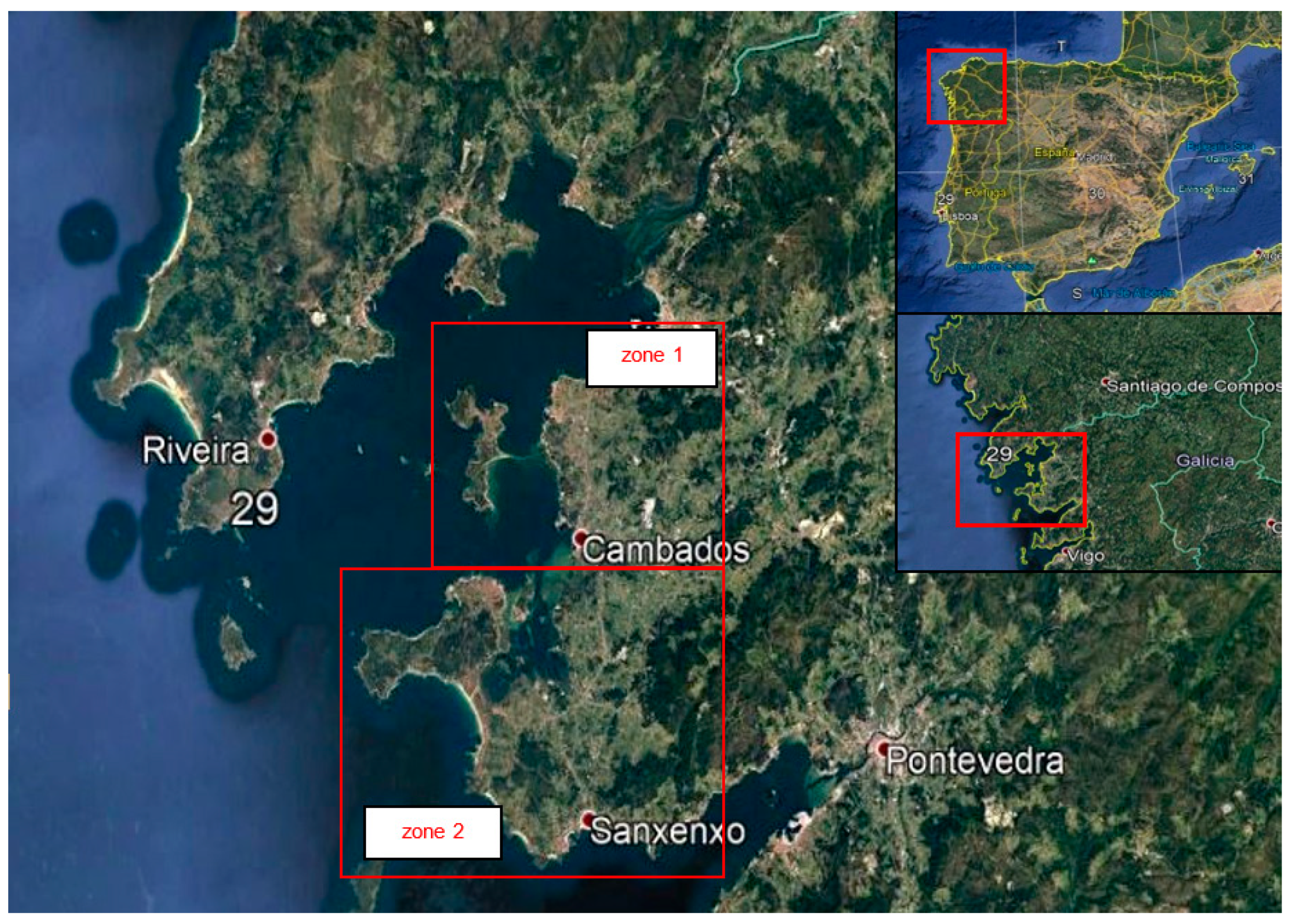
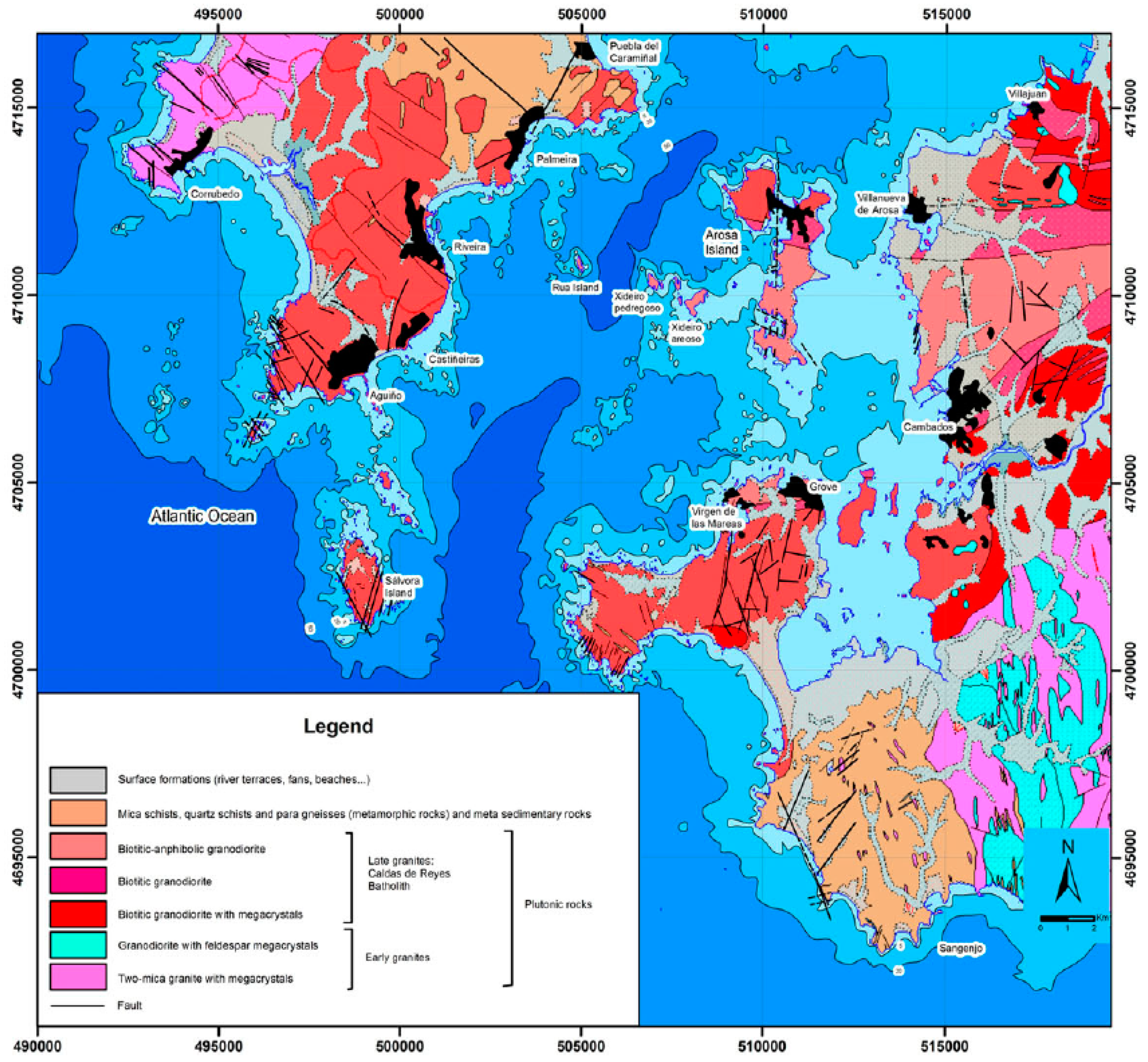
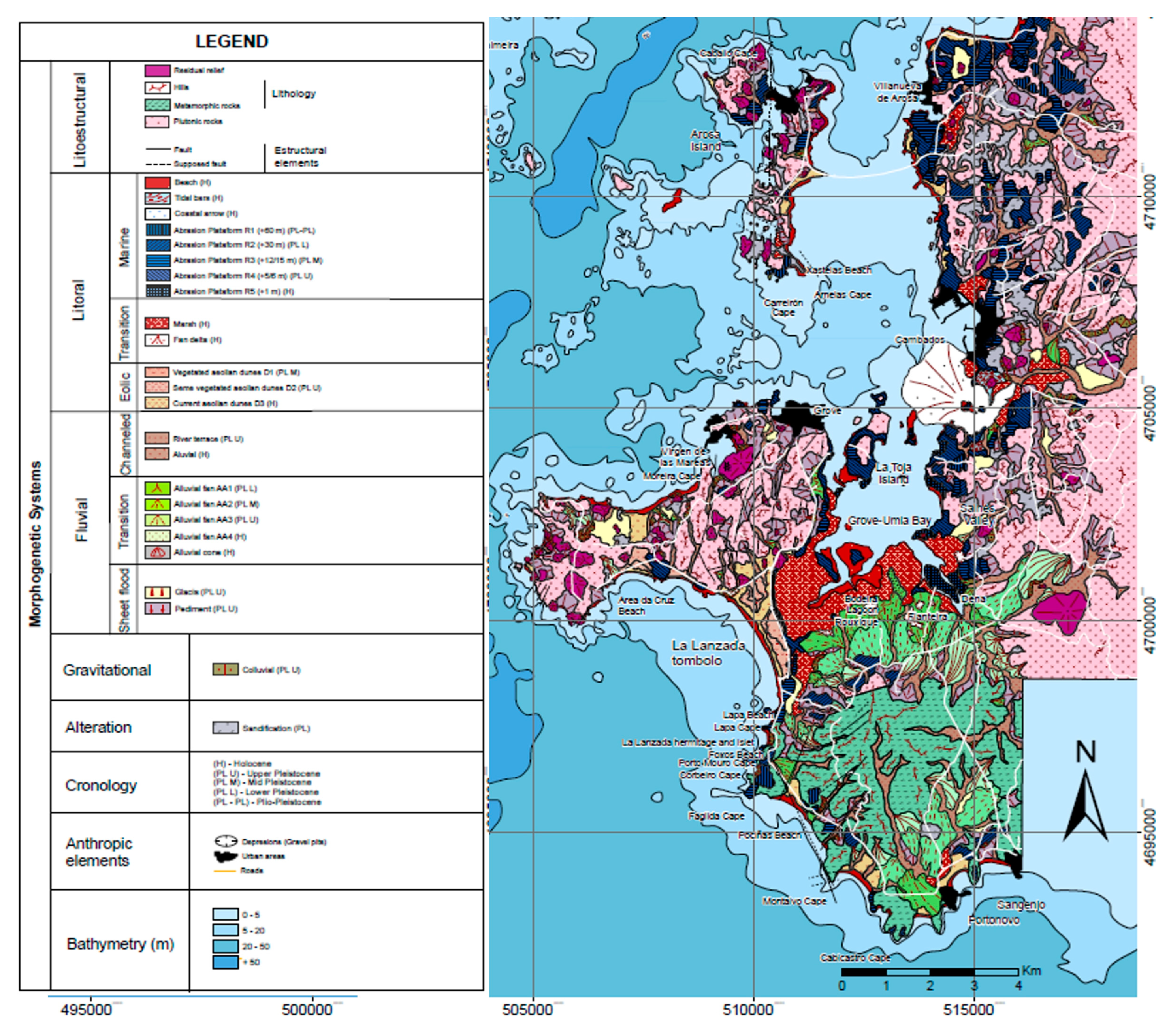
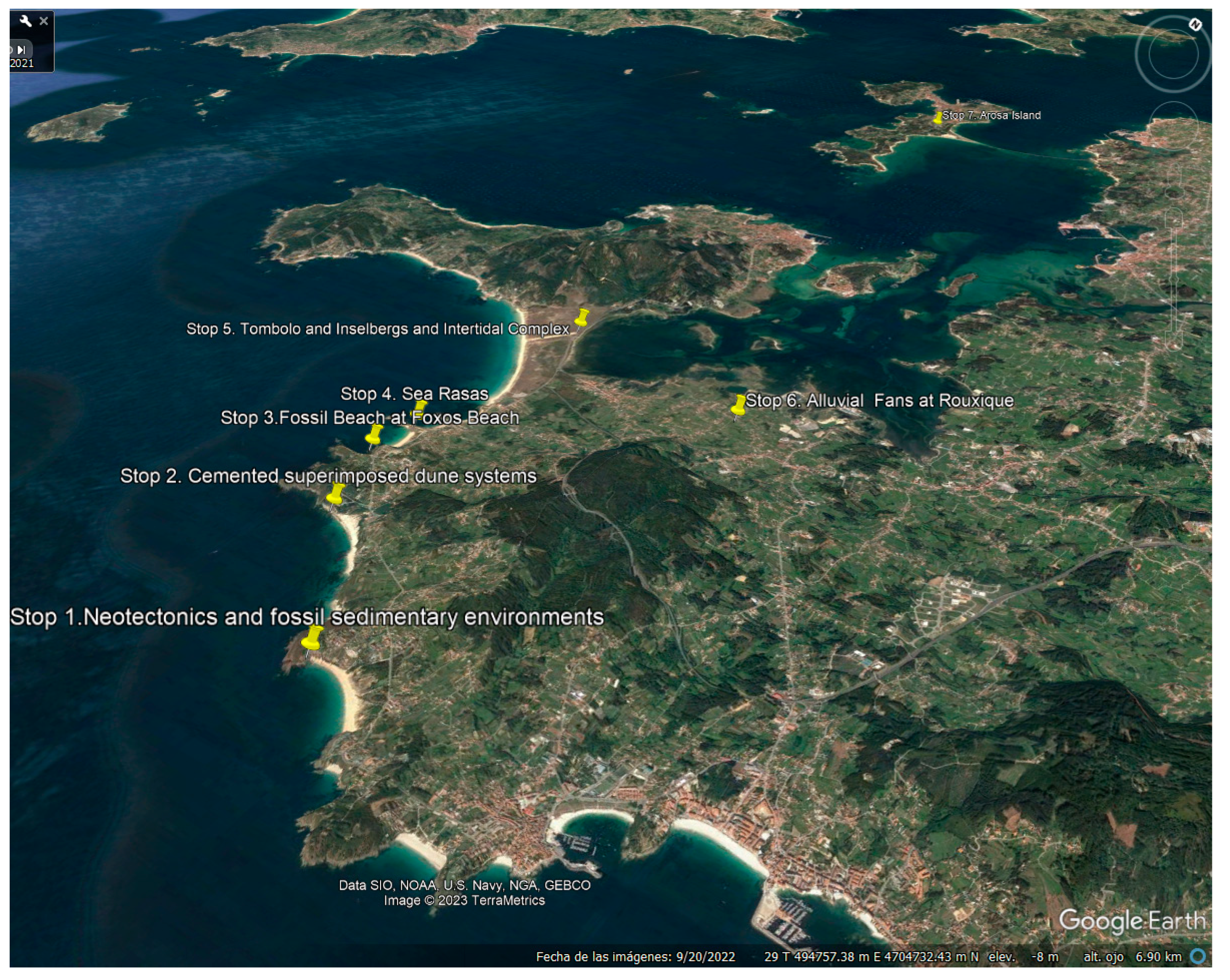

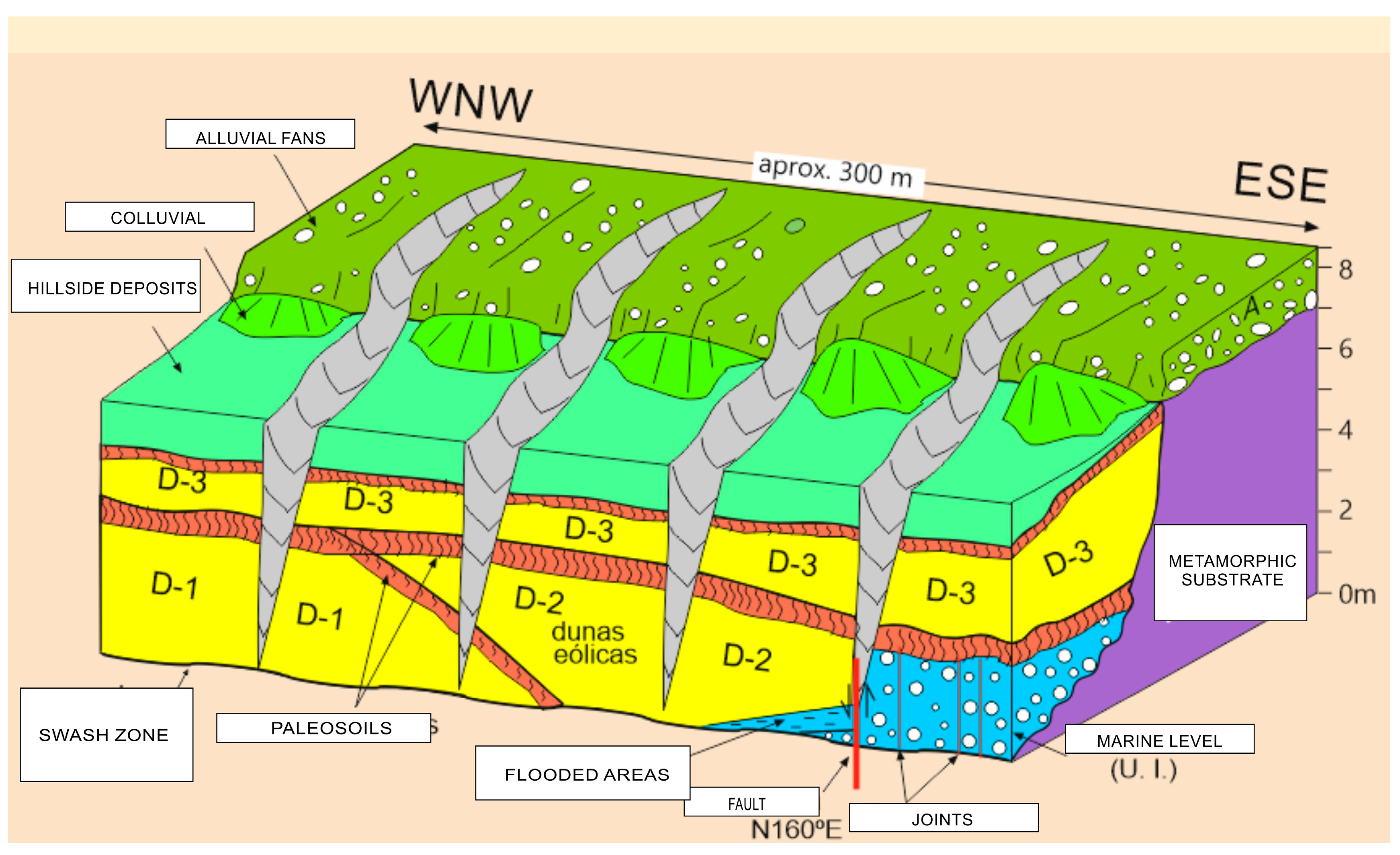
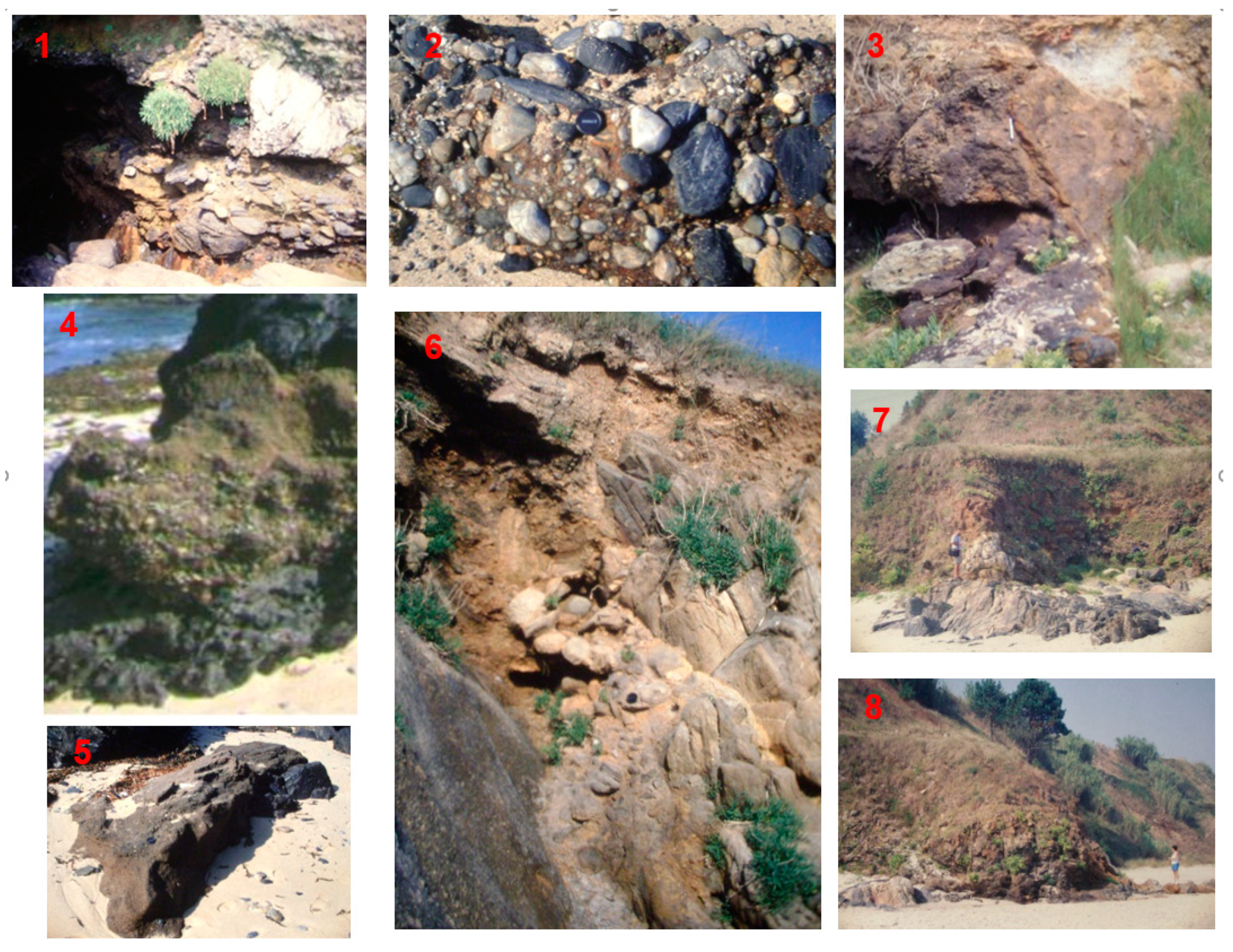
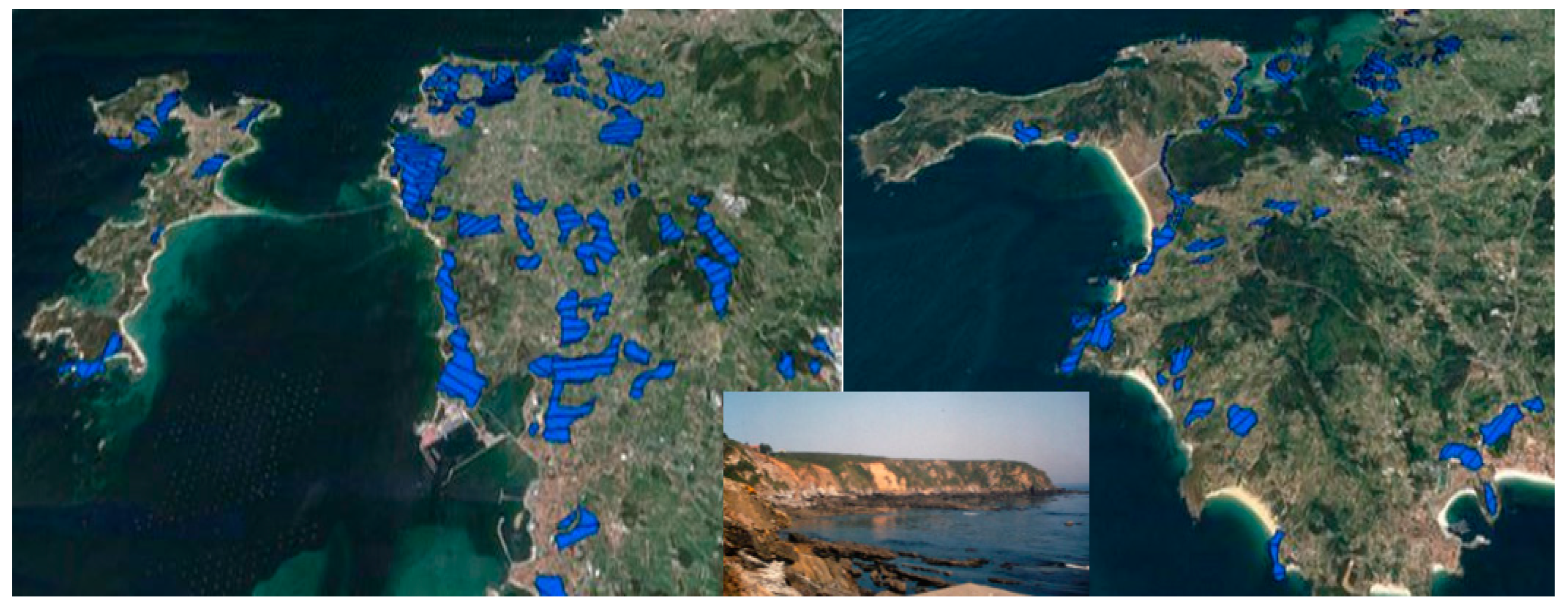
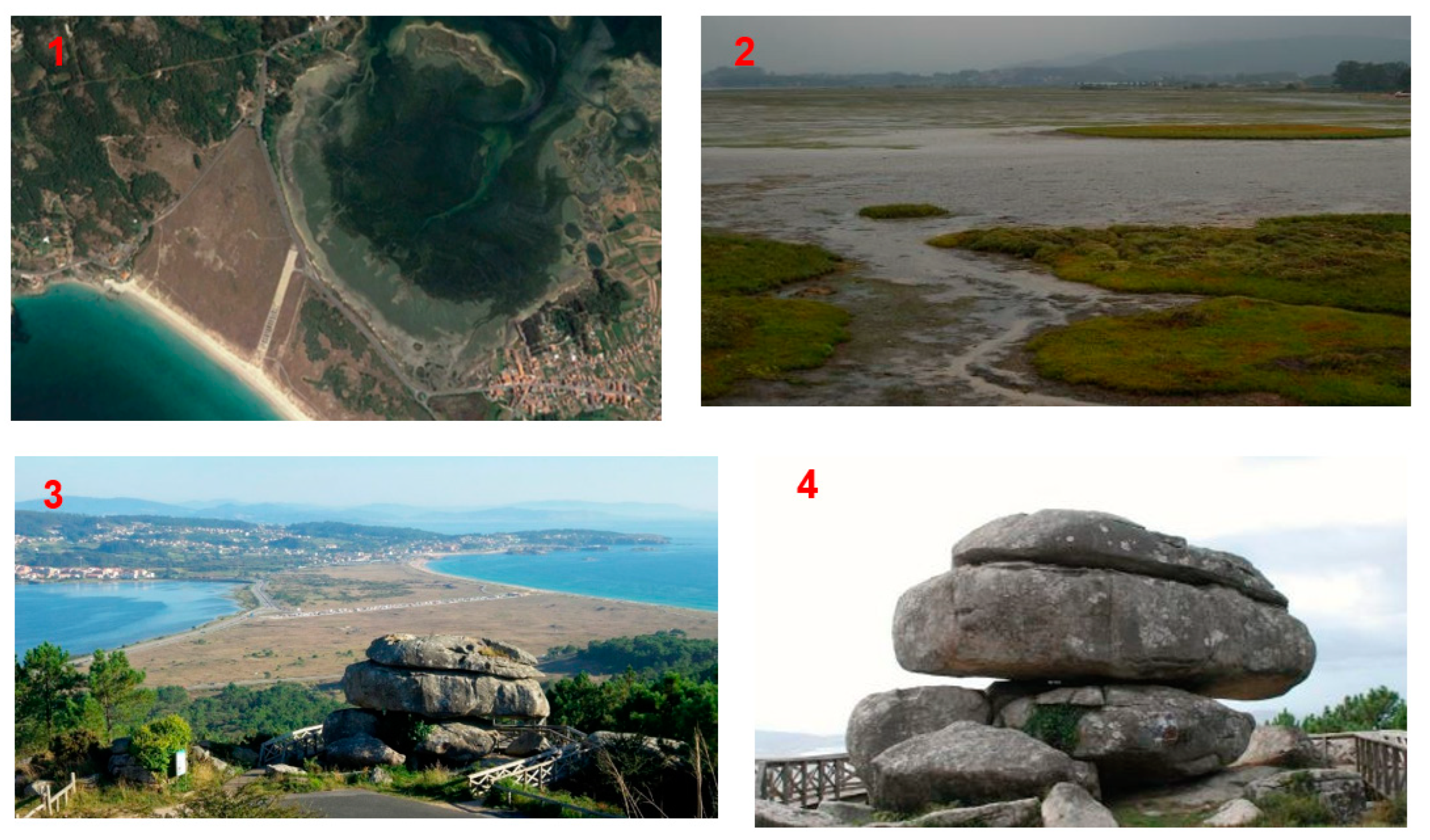
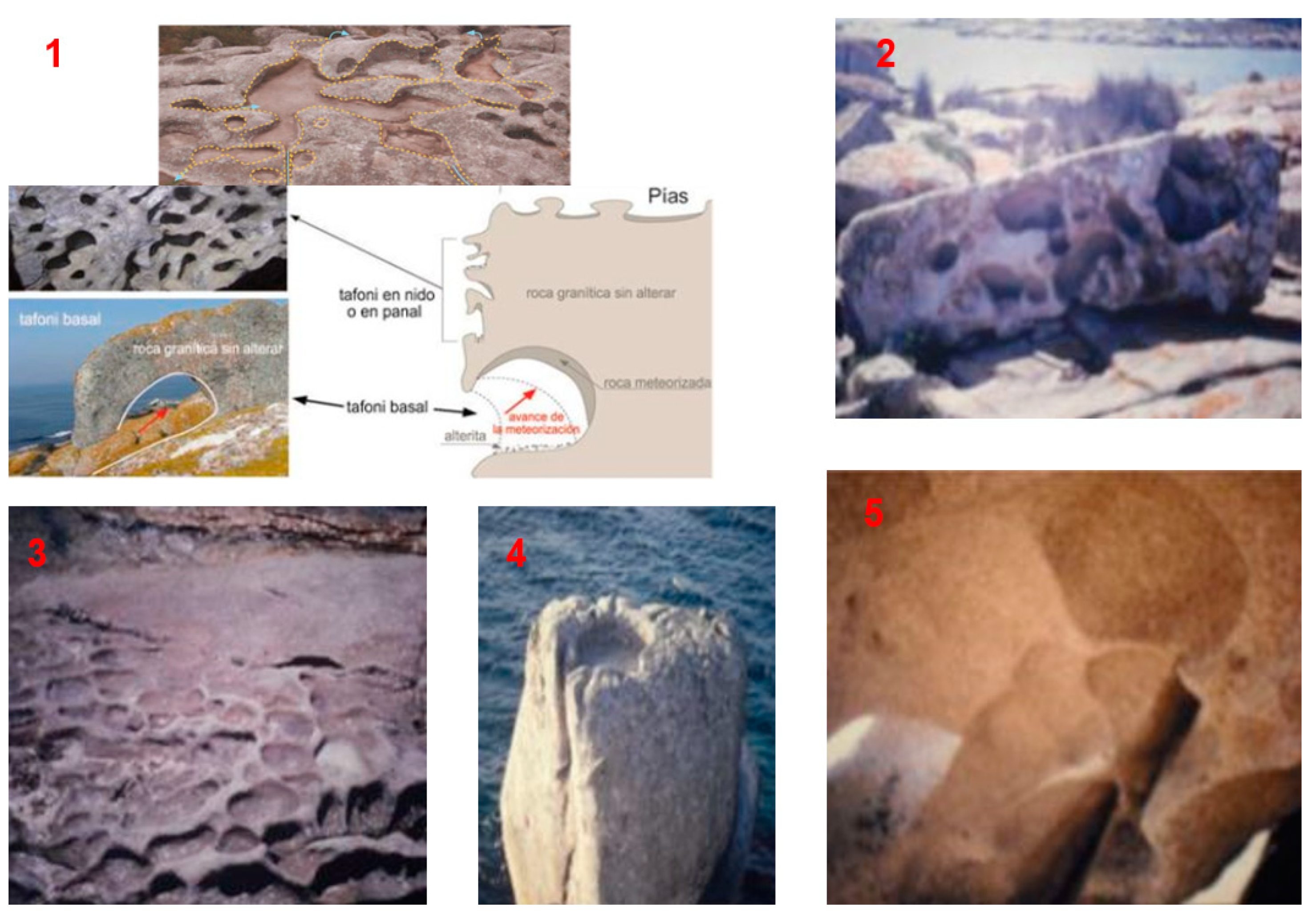
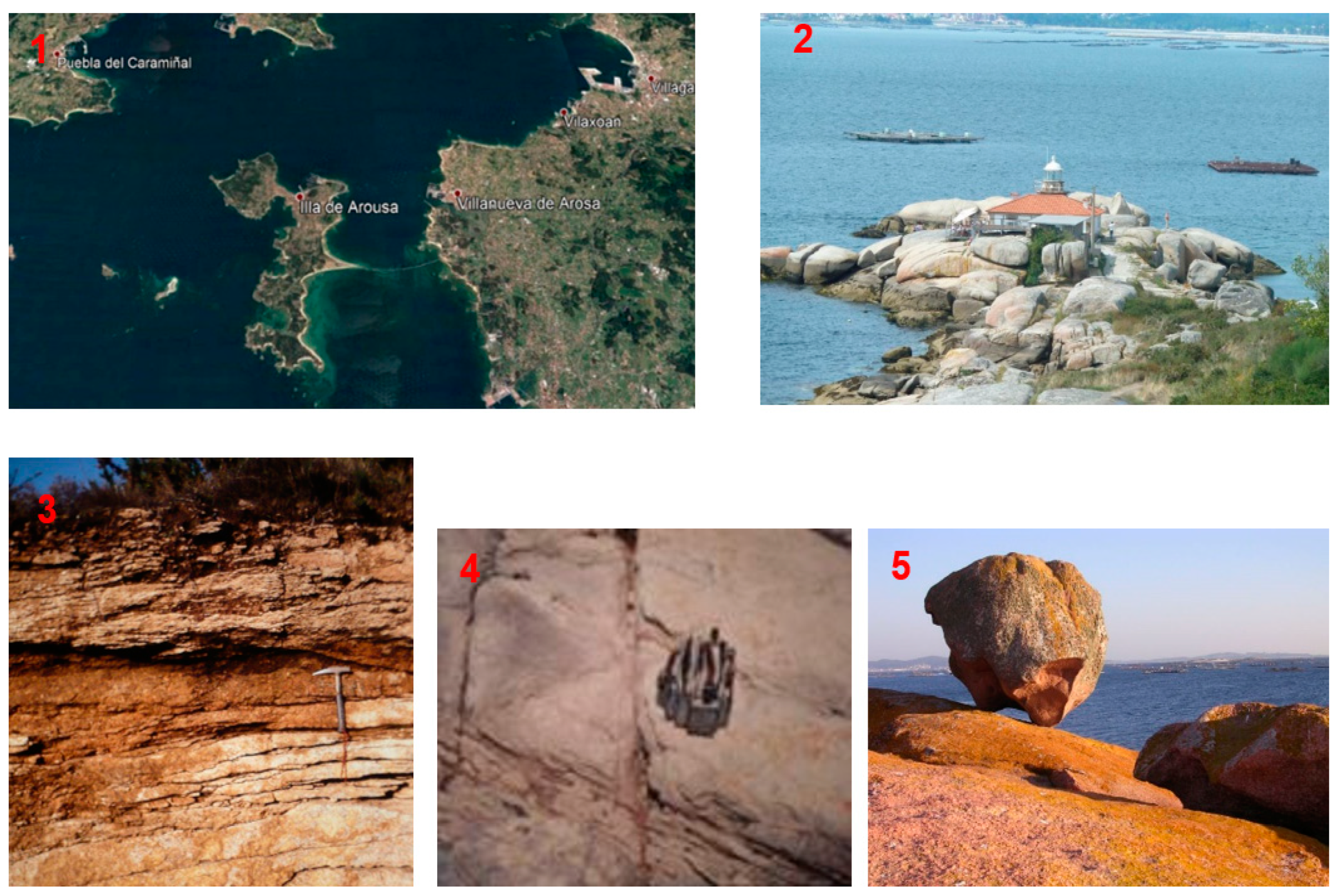

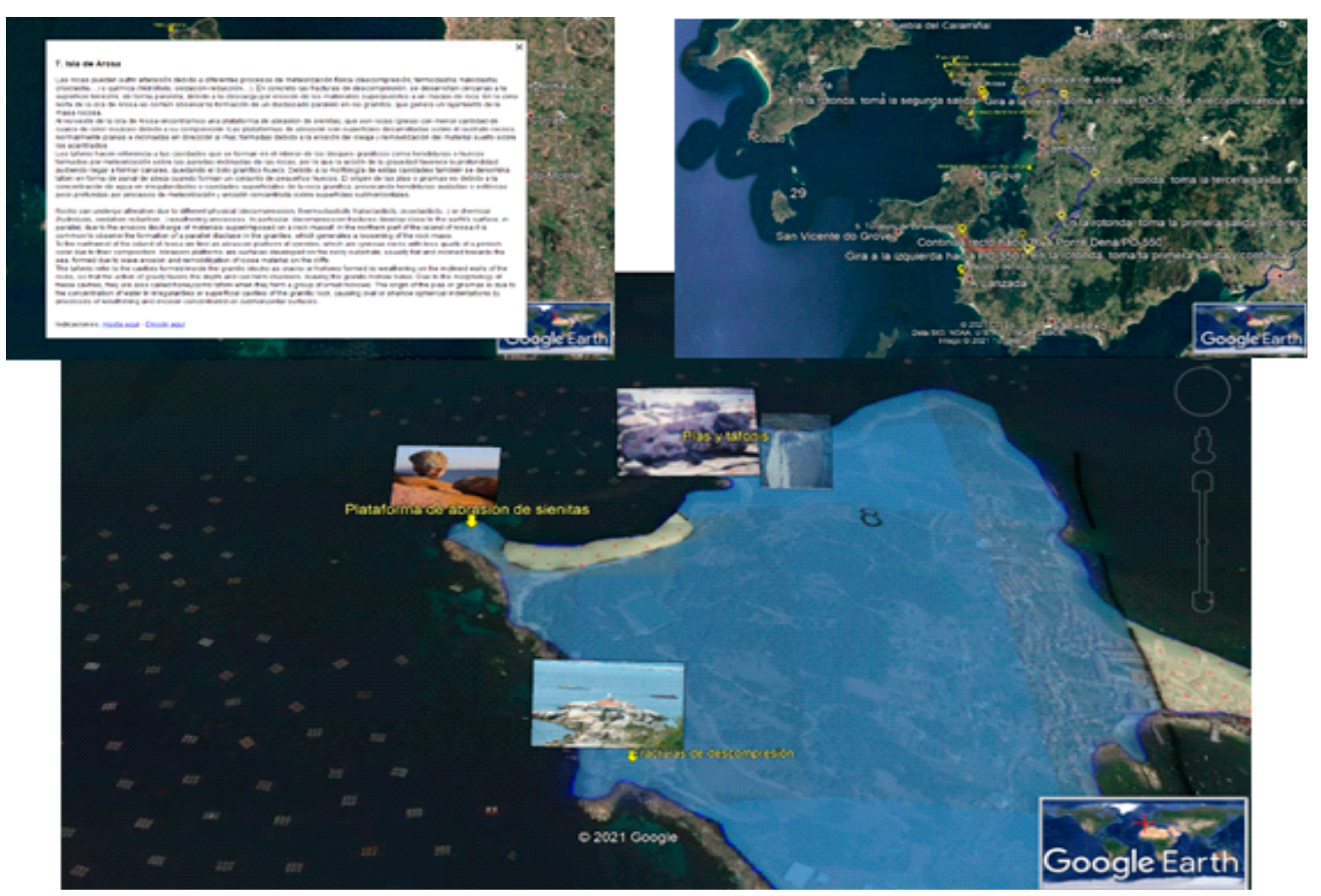
| Parameter | Scientific Interest | Educational Interest | Tourist/Recreational Interest |
|---|---|---|---|
| Representativeness (R) | 30 | 5 | --- |
| Character type locality (T) | 10 | 5 | --- |
| Degree of scientific knowledge of the location (K) | 15 | --- | --- |
| State of conservation (C) | 10 | 5 | --- |
| Viewing conditions (O) | 10 | 5 | 5 |
| Rarity (A) | 15 | 5 | --- |
| Geological diversity (D) | 10 | 10 | --- |
| Learning objectives/educational use (Cdd) | --- | 20 | --- |
| Logistics infrastructure (Il) | --- | 15 | 5 |
| Population density (Dp) | --- | 5 | 5 |
| Accessibility (Ac) | --- | 15 | 10 |
| Intrinsic fragility (E) | --- | --- | 15 |
| Association with elements natural and/or cultural (NH) | --- | 5 | 5 |
| Beauty or spectacularity (B) | --- | 5 | 20 |
| Informative content/use (Cdv) | --- | --- | 15 |
| Potential for tourism/recreation activities (Ptr) | --- | --- | 5 |
| Proximity to recreational areas (Zr) | --- | --- | 5 |
| Socioeconomic environment (Es) | --- | --- | 10 |
| TOTAL | 100 | 100 | 100 |
| S1 | S2 | S3 | S4 | S5 | S6 | S7 | |
|---|---|---|---|---|---|---|---|
| Representativeness | 2 | 2 | 2 | 2 | 2 | 2 | 2 |
| Character type locality | 1 | 1 | 1 | 1 | 1 | 1 | 1 |
| Degree of scientific knowledge about the place | 4 | 4 | 2 | 2 | 2 | 2 | 2 |
| State of conservation | 2 | 2 | 2 | 2 | 2 | 2 | 4 |
| Viewing conditions | 4 | 4 | 4 | 4 | 4 | 2 | 4 |
| Rarity | 0 | 0 | 2 | 2 | 0 | 0 | 2 |
| Geological diversity | 4 | 4 | 2 | 0 | 0 | 2 | 4 |
| Learning objectives/educational use | 2 | 2 | 2 | 2 | 2 | 2 | 2 |
| Logistics infrastructure | 4 | 4 | 4 | 4 | 4 | 4 | 4 |
| Population density | 2 | 2 | 2 | 2 | 2 | 2 | 2 |
| Accessibility | 1 | 0 | 0 | 4 | 4 | 2 | 2 |
| Intrinsic fragility | 1 | 1 | 0 | 1 | 4 | 4 | 1 |
| Association with elements of nature/culture heritage | 4 | 4 | 4 | 4 | 4 | 4 | 4 |
| Beauty or spectacularity | 1 | 1 | 1 | 0 | 1 | 1 | 1 |
| Informative content/use | 2 | 2 | 2 | 2 | 2 | 2 | 2 |
| Potential for activities tourism/recreation | 1 | 2 | 2 | 2 | 2 | 1 | 1 |
| Proximity to recreational areas | 4 | 4 | 4 | 4 | 4 | 4 | 4 |
| Socioeconomic environment | 1 | 1 | 1 | 1 | 1 | 1 | 1 |
| Total | 36 | 37 | 37 | 39 | 41 | 38 | 43 |
| S1 | S2 | S3 | S4 | S5 | S6 | S7 | |
|---|---|---|---|---|---|---|---|
| Scientific interest (Vc) | 230 | 230 | 210 | 160 | 160 | 160 | 200 |
| Educational interest (Vd) | 235 | 225 | 210 | 220 | 240 | 230 | 245 |
| Tourist/recreational interest (Vt) | 180 | 175 | 160 | 195 | 260 | 225 | 190 |
| Total | 565 | 630 | 580 | 575 | 660 | 615 | 635 |
| Vc = value out 10 | 5.8 | 5.8 | 5.3 | 4.0 | 4.0 | 4.0 | 5.0 |
| Vd = value out 10 | 5.9 | 5.6 | 5.3 | 5.5 | 6.0 | 5.8 | 6.1 |
| Vt = value out 10 | 4.5 | 4.4 | 4.0 | 4.9 | 6.5 | 5.6 | 4.8 |
| Vc = algorithm | 95 | 95 | 90 | 74 | 74 | 74 | 84 |
| Vd = algorithm | 66 | 63 | 59 | 63 | 65 | 64 | 68 |
| Vt = algorithm | 44 | 42 | 36 | 42 | 69 | 62 | 46 |
| S1 | S2 | S3 | S4 | S5 | S6 | S7 | |
|---|---|---|---|---|---|---|---|
| Geosite size factor (EF) | 0.015 | 0.008 | 0.015 | 0.008 | 0.003 | 0.003 | 0.003 |
| Fragility (F) | 5 | 20 | 10 | 5 | 20 | 10 | 5 |
| Natural threats (AN) | 10 | 20 | 10 | 20 | 20 | 1 | 10 |
| Degradation susceptibility (SDN) | 0.75 | 3.00 | 1.5 | 0.75 | 1.00 | 0.03 | 0.13 |
| Interest for mining or water exploitation (VuM) | 0 | 0 | 0 | 0 | 2 | 0 | 4 |
| Vulnerability to plunder (VuEX) | 0 | 1 | 0 | 0 | 0 | 0 | 0 |
| Proximity to activities and infrastructures (VuI) | 1 | 1 | 1 | 1 | 1 | 2 | 4 |
| Accessibility (Ac) | 1 | 0 | 1 | 1 | 4 | 1 | 4 |
| Protection regime(P) | 4 | 4 | 4 | 4 | 1 | 4 | 4 |
| Physical or indirect protection (PF) | 4 | 4 | 4 | 4 | 4 | 4 | 4 |
| Land ownership and access regime (TS) | 4 | 4 | 4 | 4 | 4 | 4 | 4 |
| Population density (DP) | 2 | 2 | 2 | 2 | 2 | 2 | 2 |
| Proximity to recreational areas (ZR) | 4 | 4 | 4 | 4 | 4 | 4 | 4 |
| Anthropic degradation susceptibility (SDA) | 1.73 | 0.98 | 1.73 | 0.86 | 0.45 | 0.33 | 0.73 |
| Degradation Risk (RDNC) | 0.435 | 1.74 | 0.795 | 0.3 | 0.4 | 0.01 | 0.06 |
| Degradation Risk (RDND) | 0.4425 | 1.68 | 0.795 | 0.412 | 0.6 | 0.0145 | 0.076 |
| Degradation Risk (RDNT) | 0.337 | 1.32 | 0.6 | 0.367 | 0.65 | 0.014 | 0.06 |
| Degradation Risk (RDAC) | 1.000 | 0.5655 | 0.914 | 0.345 | 0.18 | 0.13 | 0.348 |
| Degradation Risk (RDAD) | 1.017 | 0.546 | 0.914 | 0.474 | 0.27 | 0.188 | 0.442 |
| Degradation Risk (RDAT) | 0.776 | 0.429 | 0.69 | 0.422 | 0.2925 | 0.182 | 0.348 |
Disclaimer/Publisher’s Note: The statements, opinions and data contained in all publications are solely those of the individual author(s) and contributor(s) and not of MDPI and/or the editor(s). MDPI and/or the editor(s) disclaim responsibility for any injury to people or property resulting from any ideas, methods, instructions or products referred to in the content. |
© 2023 by the authors. Licensee MDPI, Basel, Switzerland. This article is an open access article distributed under the terms and conditions of the Creative Commons Attribution (CC BY) license (https://creativecommons.org/licenses/by/4.0/).
Share and Cite
Martínez-Graña, A.; González-Delgado, J.A.; Nieto, C.; Villalba, V.; Cabero, T. Geodiversity and Geoheritage to Promote Geotourism Using Augmented Reality and 3D Virtual Flights in the Arosa Estuary (NW Spain). Land 2023, 12, 1068. https://doi.org/10.3390/land12051068
Martínez-Graña A, González-Delgado JA, Nieto C, Villalba V, Cabero T. Geodiversity and Geoheritage to Promote Geotourism Using Augmented Reality and 3D Virtual Flights in the Arosa Estuary (NW Spain). Land. 2023; 12(5):1068. https://doi.org/10.3390/land12051068
Chicago/Turabian StyleMartínez-Graña, Antonio, José Angel González-Delgado, Carlos Nieto, Vanessa Villalba, and Teresa Cabero. 2023. "Geodiversity and Geoheritage to Promote Geotourism Using Augmented Reality and 3D Virtual Flights in the Arosa Estuary (NW Spain)" Land 12, no. 5: 1068. https://doi.org/10.3390/land12051068
APA StyleMartínez-Graña, A., González-Delgado, J. A., Nieto, C., Villalba, V., & Cabero, T. (2023). Geodiversity and Geoheritage to Promote Geotourism Using Augmented Reality and 3D Virtual Flights in the Arosa Estuary (NW Spain). Land, 12(5), 1068. https://doi.org/10.3390/land12051068








